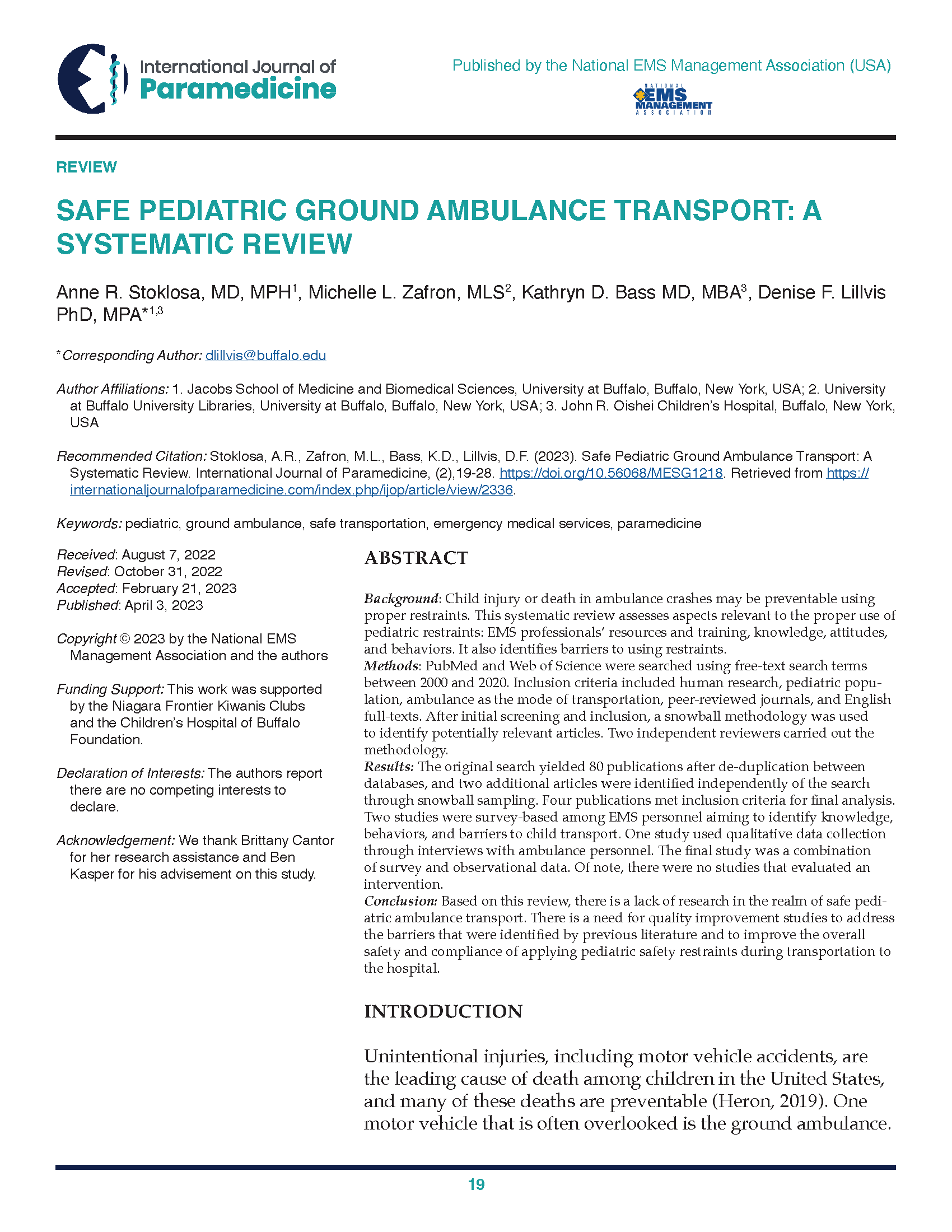Safe Pediatric Ground Ambulance Transport A Systematic Review
Main Article Content
Abstract
Background: Ambulance crashes that result in child injury or death are preventable with the use of proper restraints. This systematic review assesses aspects relevant to the proper use of pediatric restraints: EMS professionals’ resources and training, knowledge, attitudes, and behaviors. It also identifies barriers to using restraints.
Methods: PubMed and Web of Science were searched using free-text search terms between the years 2000 and 2020. Inclusion criteria included human research, pediatric population, ambulance as the mode of transportation, peer-reviewed journals, and English full-texts. After initial screening and inclusion, a snowball methodology was used to further identify potentially relevant articles. The methodology was carried out by two independent reviewers.
Results: The original search yielded 80 publications after de-duplication between databases, and two additional articles were identified independently of the search through snowball sampling. Four publications met inclusion criteria for final analysis. Two studies were survey-based among EMS personnel aiming to identify knowledge, behaviors, and barriers to child transport. One study used qualitative data collection by interviews of ambulance personnel. The final study was a combination of survey and observational data. Of note, there were no studies that evaluated an intervention.
Conclusion: Based on this review, there is a lack of research in the realm of safe pediatric ambulance transport. There is a need for quality improvement studies to address the barriers that were identified by previous literature and to improve the overall safety and compliance of pediatric safety restraints during transportation to the hospital.
Article Details

This work is licensed under a Creative Commons Attribution-ShareAlike 4.0 International License.
Publishing in IJOP allows authors to keep their copyright while giving IJOP unrestricted copyright permissions. Articles published in IJOP use Creative Common Attribution 4.0 International (CC BY-ND 4.0) licensing. This license requires that re-users give credit to the creator. It allows re-users to copy and distribute the material in any medium or format in unadapted form only, even for commercial purposes. Additional terms apply and can be accessed here.
Publishing in IJOP also allows authors to have contracts for non-exclusive distribution of the Journal's published version of the article, such as posting to an institutional repository or publication in a book, on the condition that the original publication in the original layout format in IJOP is retained and acknowledged.
We permit and encourage authors to post the articles they published in IJOP on their affiliated websites. This helps share the information, encourages citation in other works, and promotes scholarly discourse in the spirit of open access.
References
Bae, J.Y., Anderson, E., Silver, D., Macinko, J. (2014). Child passenger safety laws in the United States, 1978-2010: policy diffusion in the absence of strong federal intervention. Soc Sci Med. Jan;100:30-7. https://doi.org/10.1016/j.socscimed.2013.10.035
Damschroder, L.J., Aron, D.C., Keith, R.E., Kirsh, S.R., Alexander, J.A., Lowery, J.C. (2009). Fostering implementation of health services research findings into practice: a consolidated framework for advancing implementation science. Implement Sci. 2009;4:50. Epub 2009/08/12. https://doi.org/10.1186/1748-5908-4-50
Distance CME (2022). Live BLS NCCP + Anytime [Internet]. Available from: https://www.distancecme.com/course/live-bls-nccp-anytime/?portfolioID=1314
Fidacaro, G.A., Jr., Jones, C.W., Drago, L.A. (2020) Pediatric Transport Practices Among Prehospital Providers. Pediatr Emerg Care. 36(11):e632-e5. Epub 2018/08/15. https://doi.org/10.1097/pec.0000000000001564
Heron M. (2019) Deaths: Leading Causes for 2019. Natl Vital Stat Rep. Jul;70(9):1-114.
Maguire, B.J., Hunting, K.L., Smith, G.S., Levick, N.R. (2002). Occupational fatalities in emergency medical services: a hidden crisis. Ann Emerg Med. Dec;40(6):625-32. https://doi.org/10.1067/mem.2002.128681
Johnson, T.D., Lindholm, D., Dowd, M.D. (2006). Child and provider restraints in ambulances: knowledge, opinions, and behaviors of emergency medical services providers. Acad Emerg Med. 13(8):886-92. Epub 2006/07/11. https://doi.org/ 10.1197/j.aem.2006.03.562
National Association of State Emergency Medical Services Officials. (2012). Pediatric Transport Products for Ground Ambulances. Available from: https://nasemso.org/wp-content/uploads/Pediatric-Transport-Products-for-Ground-Ambulances_v2.2.pdf
National Association of State Emergency Medical Services Officials (2020). National Emergency Medical Services Assessment 2020. Available from: https://nasemso.org/wp-content/uploads/2020-National-EMS-Assessment_Reduced-File-Size.pdf
National Highway Traffic Safety Administration. (2014). The National Highway Traffic Safety Administration and Ground Ambulance Crashes. Available from: https://www.ems.gov/pdf/GroundAmbulanceCrashesPresentation.pdf
New York State Department of Health. (2020). New York: Renewal of Certification through Continuing Education (Pilot) Program [Internet]. Available from: https://www.health.ny.gov/professionals/ems/certification/cmerecert.htm
Öberg, M., Vicente, V., Wahlberg, A.C. (2015). The Emergency Medical Service personnel’s perception of the transportation of young children. Int Emerg Nurs. 23(2):133-7. Epub 2014/08/02. https://doi.org/10.1016/j.ienj.2014.06.192.
O’Neil, J., Steele, G.K., Weinstein, E., Collins, R., Talty, J., Bull, M.J. (2014). Ambulance transport of noncritical children: emergency medical service providers’ knowledge, opinions, and practice. Clin Pediatr (Phila). Mar;53(3):250-5. Epub 2014 Jan 9. https://doi.org/ 10.1177/0009922813517168
Shah, M.N., Cushman, J.T., Davis, C.O., Bazarian, J.J., Auinger, P., Friedman, B. (2008). The epidemiology of emergency medical services use by children: an analysis of the National Hospital Ambulatory Medical Care Survey. Prehosp Emerg Care. Jul-Sep;12(3):269-76. https://doi.org/10.1080/10903120802100167
U.S. Department of Health and Human Services Health Resources and Services Administration, U.S. Department of Transportation National Highway Traffic Safety Administration. The Dos and Don’ts of Transporting Children in an Ambulance. Emergency Medical Services for Children. Available from: https://one.nhtsa.gov/people/injury/ems/Archive/new%20Folder/childam.html
U.S. Department of Transportation, National Highway Traffic Safety Administration (NHTSA). Working Group Best-Practice Recommendations for the Safe Transportation of Children in Emergency Ground Ambulances. (2012). September 2012. Available from: www.ems.gov/bestpracticerecomendations.htm.
Watanabe, B.L., Patterson, G.S., Kempema, J.M., Magallanes, O., Brown, L.H. (2019). Is Use of Warning Lights and Sirens Associated With Increased Risk of Ambulance Crashes? A Contemporary Analysis Using National EMS Information System (NEMSIS) Data. Ann Emerg Med. Jul;74(1):101-109. Epub 2019 Jan 12. https://doi.org/10.1016/j.annemergmed.2018.09.032

